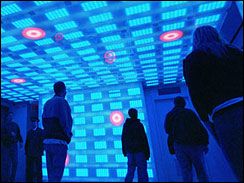Modern designers are just as innovative in their use of high-tech artificial light. All in all, it's a bright idea, as Martha Teichner now shows us:
Revolutionary is the operative word, even if exuberant, dazzling, nifty, cool also come to mind..
Imagine light in 16 million colors … fabric that can soak up the sun during the day and illuminate the third world at night. No plugs, no lightbulbs.

LED lighting systems are changing the way architecture is illuminiated. (Color Kinetics)
All of this exists now, thanks to a tiny computer chip with a bright idea. It's called an LED, a light-emitting diode, and if it hasn't already begun to change everything you thought you knew about light, it will.
"Ten years ago, LEDs were kinds the trinkets," General Electric VP Michael Petras said. "It was keychain lights."
These chips the size of a grain of salt that emits light were actually invented at GE in 1962, by a man named Nick Holanyak. In the beginning they only came in red and the applications were limited: traffic signals, brake lights, on-off switches.
"So now it's into the big scoreboards at the stadiums or the concerts," Petras said. "We've got it in refrigeration cases at retail supermarkets. We have it in signs."
By the late 1990s, engineers had added green and blue, which meant they could create every color imaginable - and finally white.
Suddenly there was an LED innovation explosion. Times Square is practically passé. This trailer from Video Roadshow is state-of-the-art for now, though Jeff Studley says in a couple of years it will be obsolete. "There'll be things we can't even imagine," he said.
And some reinventions of things we know very well.
LEDs are utilitarian. In addition to low energy use and a long life, they don’t produce much heat. In fact, they produce a cold beam.
Utilitarian is good, but sexy is ....sexy.
Kevin Dowling is vice president for innovation at Color Kinetics outside Boston. He toured a wall display that converts video to light, "so you in essence are walking into a kaleidoscope."
Dowling said the myriad lights patterns that are created, are done so entirely by software. They change and never repeat (unless you want them to).
Here's the stunning part: The light show uses the same amount of electricity as four hairdryers.
So architects, with the help of companies like Color Kinetics, are now lighting up the night, guilt-free..
What about home use, you're asking? The good news is that the cost is coming down 20% a year. But for now, LEDs are still more expensive than compact fluorescent bulbs, which (in case you hate them) are getting better.
But who can resist the promise of LEDs, the idea of a lamp-less house?
 (General Electric)
(General Electric)
[At left: Neon is so 20th Century. GE's Tetra lighting systems are flexible LEDs.]
Petras showed us an oLED, or Organic LED, which are flexible. "It can be printed onto great rolls, and come 2010 or so you'll be able to buy lengths of it, in sheets."
Where does he seem them being applied? "Wallpaper."
That's right. Wallpaper.
In the Sierra Madre mountains of Mexico, LEDs are changing lives. An organization called the Portable Light Project has provided villagers with ingenious LED-lit reflectors. Flexible solar panels are sewn onto one side of a piece of fabric.
Sheila Kennedy is a Boston architect, whose firm, Kennedy & Violich Architecture, developed the units.
"You simply take this material, put it out in the sun for about 2 1/2 or 3 hours, it harvests the sunlight, turns it into electricity," Kennedy said, "and then you can use that electricity for about six or seven hours at night."
LEDs mean years of free light for people who need it … nights filled with possibility for us all, as we consider light … in a new light.








 (General Electric)
(General Electric)



